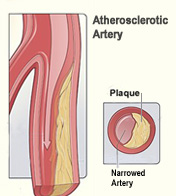Upper & Lower Extremity Arterial Insufficiency
While it is relatively rare for atherosclerosis to affect the upper extremities and cause symptoms, arterial insufficiency to the lower extremities affects a large segment of the elderly population, many of whom are asymptomatic during the early stages of their illness.
Symptoms
Symptoms or Indications of Upper Extremity Arterial Insufficiency include:
- Discomfort or pain in your arms
- Tightness, heaviness, cramping, or weakness in one or both of your arms
Symptoms or Indications of Lower Extremity Arterial Insufficiency include:
- Chronic arterial occlusive disease
- Claudication (Pain or cramping in the legs that occurs during walking or exercise and is relieved by rest)
- Rest Pain (Severe pain in the legs that occurs while at rest)
- Ulceration
- Gangrene
- Acute arterial occlusion: (When blood flow in a leg artery suddenly stops--Symptoms are pain, pallor, pulselessness, paralysis, skin cold to the touch)
- Aneurysm
- Pseudoaneurysm
Diagnosis

Tests to diagnose include:
Angiography of the arteries in the legs.
Duplex ultrasonography of the upper and lower extremity arteries provides an overview of the location, extent and severity of vascular disease. The lower extremity Doppler evaluation is performed from the iliacs through the tibial vessels and extended into the foot, the upper extremity can be performed from the subclavian artery to the wrist.
A Doppler ultrasound may also be performed to capture images of the movement of blood through your arteries. This test helps to determine how the blood is flowing through your arteries. Arterial duplex can show plaque buildup in arteries to help detect peripheral vascular disease (PVD).
Treatment Options
If you have high blood pressure, your physician may prescribe blood pressure medication to lower your overall blood pressure and the pressure on the weakened area of the aneurysm. Additionally, your physician may prescribe a statin (or cholesterol-lowering medication) to maintain the health of your blood vessels. Lifestyle changes to stop smoking, control weight, blood sugar and cholesterol may also be recommended.
Surgery or a minimally invasive procedure may be performed if the condition is severe and is affecting your ability to work or do important activities, or you are having pain at rest.
Minimally Invasive:
Angioplasty (to widen or clear the blocked vessel) with stent placement (to support the cleared vessel and keep it open), or atherectomy (to remove the blockage).
Surgery:
Peripheral artery bypass surgery to reroute blood flow around the blocked artery.
Public domain image(s) provided courtesy of The National Heart, Lung, and Blood Institute (NHLBI) http://www.nhlbi.nih.gov/health/, part of the National Institutes of Health and the U.S. Department of Health and Human Services.
 Vascular Surgery Specialists
Vascular Surgery Specialists